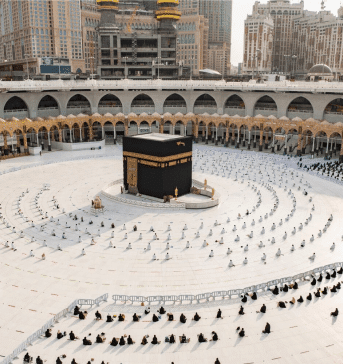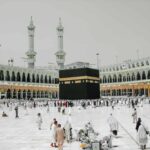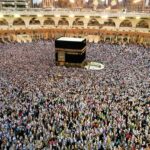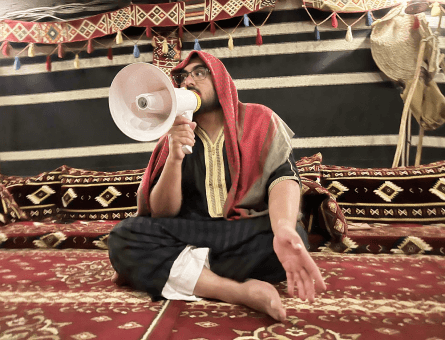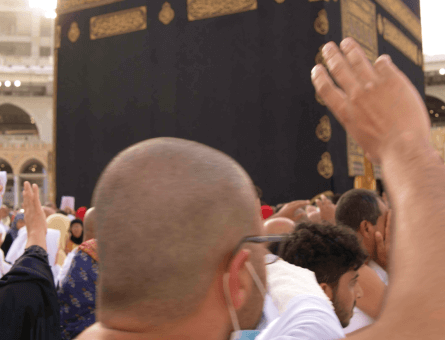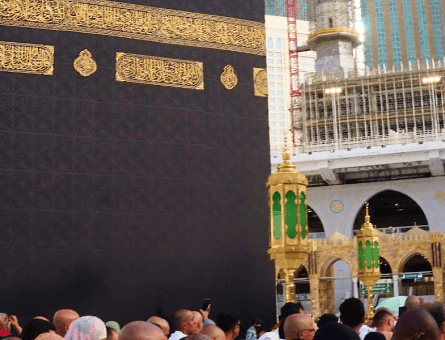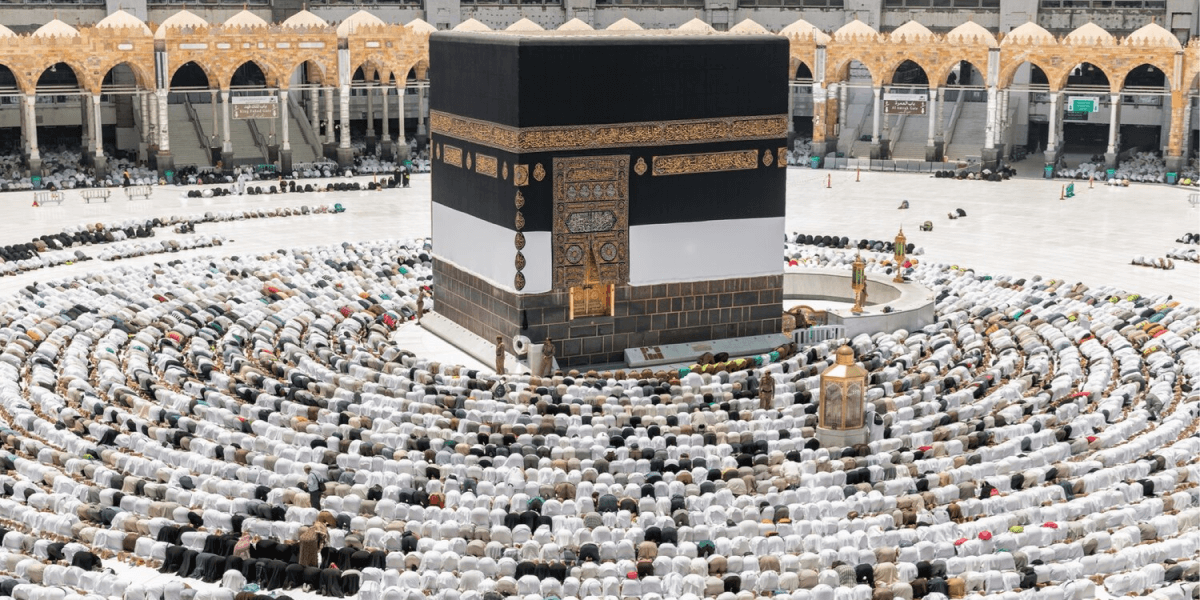Why is the Kaaba important to muslims?
Located near the centre of the Masjid Al-Haram, also known as the Great Mosque of Mecca in Saudia Arabia, the Holy Kaaba beholds great significance in Islam. Literally meaning ‘cube’ in Arabic, the Kaaba is a square-shaped shrine elegantly draped in a black-coloured cotton and silk veil. The Holy Kaaba measures ten and a half metres in breadth and length and fifteen metres in height.
Muslims cherish the aspiration of visiting it for the annual Hajj pilgrimage or Umrah and Muslims turn themselves towards the Holy Kaaba every day while performing the five compulsory congregational prayers in accordance with Allah (SWT)’s command as stated in the Holy Quran.
Other names of the Holy Kaaba include Bait-al-Haram meaning the Sacred House, and Bait-al-Atiq referring to the Kaaba as the Ancient House. Keep reading to learn why is the Kaaba important to Muslims around the world.
What Makes the Kaaba So Important?
Though the Holy Kaaba, also known as “Khana Kaaba”, isn’t the actual house of Allah (SWT), it’s the symbolic representation of the place of Allah (SWT)’s residence in this world. Therefore, it must be remembered that Muslims do not worship the Holy Kaaba. However, it is the symbol of the Supremacy and Oneness of Allah (SWT), which is also the first pillar of Islam and the foundation of every Muslim’s belief that there is no God but Allah (SWT).
Moreover, the importance of the Kaaba is proven by the fact that it is known as the Qibla. In simpler words, it is the direction that Muslims worldwide face while performing the daily prayers (Salaat).
Hajj is the fifth pillar of Islam, and therefore it is compulsory for every financially and physically stable Muslim to perform it at least once in their lifetime. Upon arriving in Mecca, Muslim pilgrims gather in the courtyard of the Great Mosque, commonly known as Masjid Al-Haram, around the Holy Kaaba. Muslims are then directed to perform Tawaf – walk around the Holy Kaaba seven times. They also intend to touch or kiss the Black Stone (Hajr e Aswad), which is in the eastern corner of the Kaaba. This act signifies the Holy Kaaba as the symbol of Muslim unity and equality in the world. This is also stated in the Holy Quran:
“O mankind, verily We have created you from a single (Pair) of a male and a female, and have made you into nations and tribes, that you may know each other. Verily the most honoured of you in the sight of Almighty Allah is the most righteous.” (Quran, 49:13)
The importance of the Holy Kaaba in Islam is proven in the following verse of the Holy Quran:
“God has appointed the Ka’bah, the Sacred House, a support for mankind, and the Sacred Month and the offerings and the garlands. That is so that you may know that God knows whatsoever is in the heavens and whatsoever is in the earth, and that God is Knower of all things.” (5:97)
Why was the Kaaba Built?
The Holy Kaaba is indeed one of the oldest religious sites on Earth. Even before the arrival of Islam, the Kaaba was one of the most sacred places of worship to the Arabs. According to Islamic history, Prophet Ibrahim (AS), along with his son Prophet Ismail (AS), constructed the Holy Kaaba following the command of Allah (SWT), as stated in the Holy Quran:
“And (remember) when Abraham and (his son) Ishmael were raising the foundations of the House (the Kaba at Mecca), (saying), ‘Our Lord! Accept (this service) from us. Verily, You are the All-Hearer, the All-Knower’” (Quran 2:127)
Based on Islamic tradition, the Holy Kaaba was initially a roofless structure. Despite the fact that Prophet Ibrahim (AS) built the Kaaba to worship Allah (SWT), the Quraysh occupied the Kaaba with idols to worship during their rule. However, during 608 CE, powerful leaders of the Quraysh tribe worked together to reconstruct the pre-Islamic Kaaba, using different kinds of wood and masonry. Moreover, because the Kaaba was initially located on active flood plains, its door was now raised above ground level to safeguard the sacred place from floodwaters and intruders.
Soon after being blessed with Prophethood, Prophet Muhammad (PBUH) and his companions and followers were driven out of Mecca to Madina in 620 CE. After the conquest of Makkah in the 8AH/630 CE, Prophet Muhammad (PBUH) destroyed all the idols in the Kaaba, returning it to the monotheism preached by Prophet Ibrahim (AS). While doing so, it is said that Prophet Muhammad (PBUH) recited the following verse of the Holy Quran:
“Truth hath come and falsehood hath vanished.” (17:81)
Since then, the Kaaba has been modified and altered extensively over the years. Though its safety structure has been changed to accommodate an ever-increasing number of pilgrims, the foundation of the Holy Kaaba remains the same. Currently, the Holy Kaaba is also home to some of the most important Islamic landmarks including Hajr e Aswad, Musallah Jibraeel and Maqam e Ibrahim.
What Is the Kaaba Made Of?
The Holy Kaaba, a cube-shaped structure, is roughly 10 by 14 metres (35 by 40 feet) at its base and 15 metres (50 feet) in height. Constructed from limestone, marble and grey stone, the Holy Kaaba is built in such a way that its corners roughly correspond to the points of the compass. Furthermore, in 1982, the door of the Holy Kaaba was also beautified using solid gold. Moreover, the exterior of the Holy Kaaba is covered with an enormous black-coloured silk cloth called the kiswah. It comprises neatly embossed Arabic calligraphy from the Quran using gold thread, making the Holy Kaaba a unique representation of Islam to the world.
Why Is the Kaaba Black?
People who don’t know might be surprised to learn that the actual colour of the Holy Kaaba isn’t black. Constructed using grey stone and marble, the structure of the Kaaba is dark grey in colour. However, to protect and honour the Holy Kaaba as the most sacred place in Islam, it is covered by an ornately embr
oidered black coloured cloth. Made from the highest quality of silk and embroidered with pure gold thread, the kiswah has a long history. Its primary purpose is to protect the Holy Kaaba from the elements. Black itself, being a dark colour, has the longest durability. Scientifically speaking, using a black cloth to cover the Holy Kaaba saves it from getting damaged by the drastic weather changes and also by getting untidy- especially after being touched by millions of Muslims every year.
“During their Caliphate, Hazrat Abu Bakr (RA), Hazrat Umar (RA), and Hazrat Usman (RA) used a pure white Egyptian cloth named “qibati” to cover the Holy Kaaba. ”
The modern-day kiswah comprises 18 pieces, crafted to cover all the four walls of the Holy Kaaba and its door. Moreover, the gold embossed comprehensively embroidered 45 metres long belt that wraps the top of the kiswah gives the sacred shrine its distinctive look. Though the kiswah used to be sent from Egypt and the pilgrims, today it is manufactured in Saudi Arabia. The black cloth covering the Holy Kaaba is changed every year on the second day of Hajj.
Who Can Go Inside the Kaaba?
Because of the overwhelming number of pilgrims every year, the Holy Kaaba is kept closed during the period of Hajj and Umrah. Moreover, due to its significance in Islam, the Saudi government has very strict rules about the people who can enter the Holy Kaaba and who cannot. While non-Muslims are strictly prohibited from entering, Muslims who visit the Holy Kaaba during other months (except from Dhul Hajj), if lucky, can be allowed to enter and pray inside the House of Allah (SWT).
Regarding the intent of praying inside the Holy Kaaba, Hazrat Aisha (RA), wife of Holy Prophet Muhammad (PBUH), narrates, “When I expressed the wish to perform salah (prayer) within the Kaabah, the Prophet (PBUH) took me by the hand and led me into the Hijr (Hateem) where he said, ‘Perform salah (prayer) here if you wish to enter the Kaabah because this is part of the Baytullah.’”
What Is Inside the Kaaba?
Made from marble and grey stone, the 180 square metre area of the Holy Kaaba’s interior comprises three wooden pillars to hold the roof in place and a number of suspended gold and silver lamps. Constructed by Abdullah bin Zubair (RA), the three pillars are 1,350 years old and have a diameter of 44cm and a perimeter of 150cm. The windowless interior of the Holy Kaaba has an enclosed staircase that leads to the ceiling. Furthermore, the door of the Holy Kaaba is covered with a silk curtain comprising silver and gold embossed engravings of Quranic verses.
Built from emblazoned colourful marbles, the inside walls of the Holy Kaaba are covered with red silk curtains embroidered with inscriptions in white. There are eight stones inside the Holy Kaaba; different Islamic scripts are inscribed on these stones. There is also a specific mark on the floor to highlight the spot where Prophet Muhammad (PBUH) prayed when he entered the Holy Kaaba.
Important Sites Near the Kaaba
The Holy Kaaba is home to some of Islam’s most valued and sacred sites. Read on to find out more!
Musallah Jibraeel
Located in the bottom right corner near the door of the Holy Kaaba, Musallah Jibraeel is said to be the spot from where angel Jibraeel (AS) taught Prophet Muhammad (PBUH) how to offer Salaat – the compulsory five daily prayers. Musallah Jibraeel is highlighted with a white-based marble embossed with eight pieces of the rarest Mary Stone that Caliph Abu Jafar al-Mansur gifted.
“The foundation of Musallah Jibreel consists of 8 pieces of rare marble Mary Stone. Although all of the pieces of the Mary Stone are different in size, the largest one is 21 cm wide and 33 cm long. It is said that the marble of Mary Stone was a gift by Caliph Abu Jafar al-Mansur.”
Hajr e Aswad
Located at the eastern side of the Holy Kaaba, Hajr e Aswad, also called the Black Stone, is one of the most important sites near the Holy Kaaba. While performing Hajj or Umrah, pilgrims from all over the world try to touch or kiss the holy stone. While stating the significance of Hajr e Aswad and calling it the heart of the Holy Kaaba, Prophet Muhammad (PBUH) said:
“Allah ordered Abraham (a) to build the Kaaba and raise its walls. Then, Abraham (a) and Ishmael (a) would build one segment of the wall each day until it reached the place of Hajar al-Aswad. At this point, a noise came from the mountain stating that it was holding something for them. Hajar al-Aswad reached Abraham, and he put there.” (Iman Al-Baqir)
Maqam Ibrahim – The Station of Ibrahim (AS)
Located approximately 43 feet east of the Holy Kaaba, Maqam Ibrahim is the stone or rock on which Prophet Ibrahim (AS) stood while constructing the Kaaba. Regarding the importance of Maqam Ibrahim, Prophet Muhammad (PBUH) states:
“The Hajre Aswad and al-Maqam (Ibrahim) are the two jewels from the jewels of Paradise. Had Allah not concealed their radiance, they would illuminate everything between the East and the West.” (Tirmidhi)
Summary – Why Is the Kaaba Important to Muslims Around the World
Being a symbol of the Oneness of Allah (SWT), the Holy Kaaba holds great significance in the hearts of Muslims around the world. Around 2 million Muslims worldwide visit the Holy Kaaba to perform the pilgrimage every year. Otherwise known as the House of Allah (SWT), the Holy Kaaba is considered one of the most sacred places on earth.
Explore The New Pilgrim App
The Ultimate App
for Hajj and Umrah!


